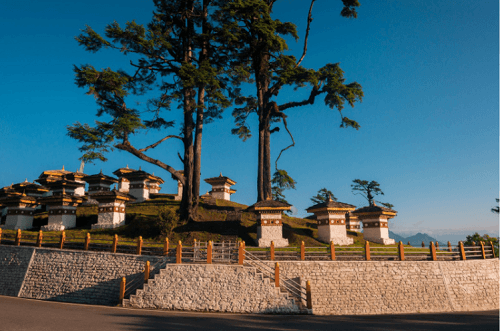
Dochula Pass is a beautiful mountain pass located between Thimphu and Punakha in Bhutan. It offers a breathtaking blend of natural beauty and rich cultural heritage.
The Dochula Pass is a historical landmark built to honor the bravery and sacrifices of the fourth king and the soldiers who perished during the battle against Assamese insurgents in 2003.
It particularly marks the victory of King Jigme Singye Wangchuck who dislodged the rebels from their camps (there were 30 camps) in Bhutanese territory from where they raided the Indian territory of Assam. After the war, the King went back to Thimphu on 28 December 2003.
This iconic landmark in Bhutan stands at an altitude of 3,100 meters and boasts panoramic views of the snow-capped mountains, including the majestic Gangkar Puensum.
Whether you're a nature lover, history enthusiast, or spiritual seeker, Dochula Pass promises an unforgettable experience. Discover the reasons why this serene haven should be on your Bhutan itinerary.
1. 108 Memorial Chortens At Dochula Pass
Ashi Dorji Wangmo Wangchuck, the eldest Queen Mother of Bhutan, built 108 memorial chortens known as “Druk Wangyal Chortens” at Dochula Pass in honor of the fourth king, His Majesty King Jigme Singye Wangchuck. The chortens were built adjacent to the country's first Royal Botanical Park.
A chorten, also known as a stupa, is a sacred structure in Buddhism that represents the Buddha's enlightened mind. It often contains relics, offerings, and sacred texts. The chortens serve as a place for prayer and meditation, making it a must-visit for those seeking a spiritual and cultural journey.
The 108 chortens at Dochula Pass are arranged in three layers, with the first layer comprising forty-five chortens, the second with thirty-six, and the topmost layer having twenty-seven, encircling the main chorten.
These chortens were constructed following specific religious rituals. As they reached a height of 1 meter, a pit was dug at the center for symbolic offerings.
As the chortens grew taller, clay images of Buddhist gods were added. The "vital stage" involved erecting the sokshing, a sacred juniper pole wrapped in silk and adorned with religious artifacts, on an auspicious day.
The 108 chortens at Dochula Pass are not only a marvel of architecture but also hold deep spiritual significance. Visitors can experience the peaceful ambiance and stunning views while reflecting on Bhutan's rich cultural heritage.

2. Breathtaking Nature Views From The Mountain Pass
If you are going to Punakha (the old capital) from the current capital of Bhutan, Thimphu, you'll definitely pass through this area. The pass was part of an ancient trail between Thimphu and Punakha, such as the Dochu La Nature Trail.
It has long served as a perfect rest stop for travelers to stretch their legs, take in the breathtaking views, and enjoy the peaceful ambiance. Surely, the Dochula Pass is one of the main highlights of your trip.
You can never take a bad photo at the stunning Dochula Pass. In fact, if you are lucky, you can even see the Himalayan range in full view on a clear day from the mountain pass. Gangkar Puensem, at 7,158 meters (23, 484 ft), the tallest unclimbed mountain in the world, can be seen from Dochula Pass.

3. The Sacred Forest And Prayer Flags
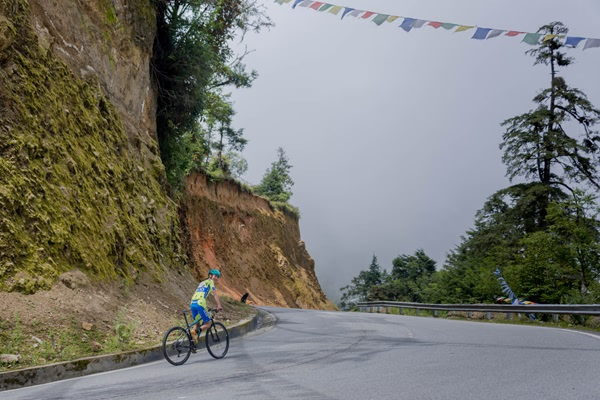
The slopes around Dochula Pass are adorned with cypress trees and colorful prayer flags, which hold deep religious significance for Buddhists.
These flags, in five colors representing natural forces—blue (sky), white (clouds), red (fire), green (water), and yellow (earth)—are inscribed with prayers to bring prosperity and peace.
The vibrant flags fluttering in the wind create a serene and spiritual atmosphere, making it a unique and tranquil spot for visitors to experience Bhutan's rich cultural traditions.
4. Dochula Pass’s Flora And Fauna
After the Losar festival in February, which marks the Bhutanese New Year, and as the snow melts, the pass provides a spectacle of many species of flowers such as the Primal Denticulata, Primula Garcilipes, rhododendrons, and Magnolia campbellii.
Another fragrant plant, that people come to enjoy is the Daphne which is a small shrub which blooms with white flowers amidst an array of prayer flags that are fixed on the slopes. The bark of this plant is used to make paper which is a traditional paper used for writing religious scriptures as it is termite-free.
5. Druk Wangyal Lhakhang
Apart from the chortens, there is a monastery built nearby called the Druk Wangyal Lhakhang. The monastery was built against the backdrop of pristine forest of the snow-covered Himalayan mountains. The construction was completed in June 2008.
The temple was built as a memorial to celebrate 100 years of monarchy in Bhutan. Paintings on themes of Bhutanese history decorate the walls of the temple. Some of the paintings include the fourth King fighting Indian rebels in the forest, monks with laptops, and a Drukair plane.
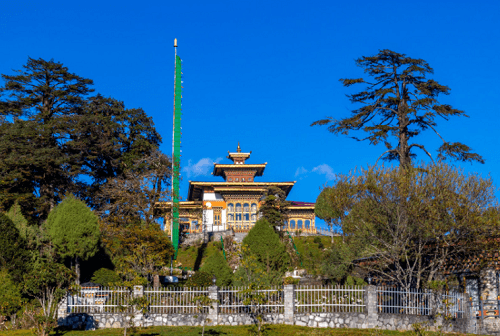
6. Dochula Druk Wangyel Festival
The open ground in front of the monastery is a venue for the annual Dochula Druk Wangyel Festival. The Dochula Druk Wangyel Tshechu is a Bhutanese festival held annually on December 13. The festival is unique in Bhutan and the performances are unlike any other festivals.
Usually, monks and laity are the ones who perform during a Bhutanese festival, but the Dochula Druk Wangyel Festival is performed by the Royal Bhutan Army. This festival was established in 2011 to commemorate the victory of the Fourth Druk Gyalpo and the Armed Forces in 2003.
A special Tsechu was composed for the occasion by Dasho Karma Ura, and it involved costumed mask dances. It is a tribute to the wise leadership of His Majesty Jigme Singye Wangchuck and to celebrate the continuous efforts of the Royal Bhutan Army in protecting the sovereignty and the stability of the country.
This one-of-a-kind tshechu is performed against the backdrop of the magnificent Himalayan mountain range.
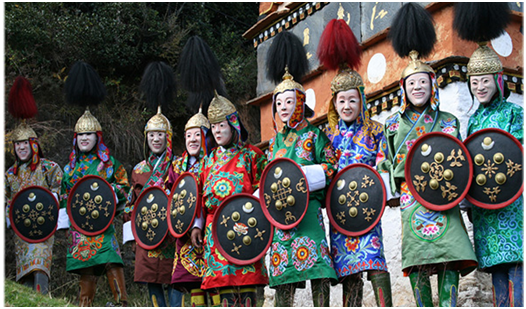
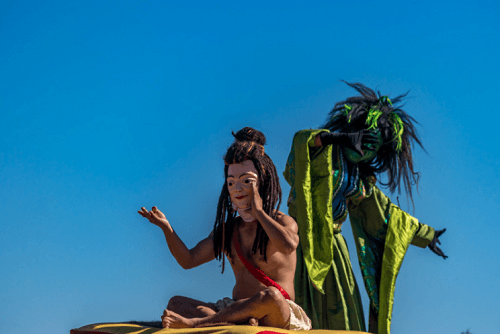

The Best Time To Visit Dochula Pass
The weather at the pass generally remains foggy and chilly. However, between October and February, panoramic views of the Bhutan Himalayas can be seen. The Dochula Pass remains beautiful in all seasons. Sometimes, you may even see snowfall at Dochula Pass and capture the chortens majestically covered in snow.
Best time to visit Bhutan
Conclusion About Dochula Pass
Dochula Pass is a beautiful mountain pass that offers a unique blend of natural beauty, cultural heritage, and spiritual significance. With stunning views of the snow-covered Himalayas and the 108 chortens, it stands as a popular tourist attraction.
For a seamless experience, consider booking with Druk Asia, a trusted Bhutan tour operator. We offer bespoke packages that provide a deep dive into Bhutanese culture and other attractions, including other mighty peaks.
Let Druk Asia guide you through this magical journey and make your visit to Dochula Pass unforgettable. Book a Bhutan tour today!
Frequently Asked Questions About Dochula Pass
Are There Any Accommodations Near Dochula Pass?
While there are no accommodations located at Dochu La Pass, however, nearby cities like Thimphu and Punakha offer a range of lodging options for travelers.
Can I Visit Dochula Pass As Part Of A Day Trip?
Yes, Dochula Pass can be easily visited as a day trip from Thimphu or Punakha, as it is located along the east-west road connecting these cities.
Is There An Entrance Fee To Visit Dochula Pass?
There is no entrance fee to visit Dochula Pass, making it accessible to all visitors. However, guided tours can enhance the experience by providing historical and cultural insights.
What Are The Passes In Bhutan?
Bhutan is home to several high mountain passes, including Dochu La Pass, Chele La Pass, Pele La Pass, and Yotong La Pass. Each pass offers unique views of the beautiful mountain pass scenery and the snow-clad mountain peaks, along with cultural and historical significance.
